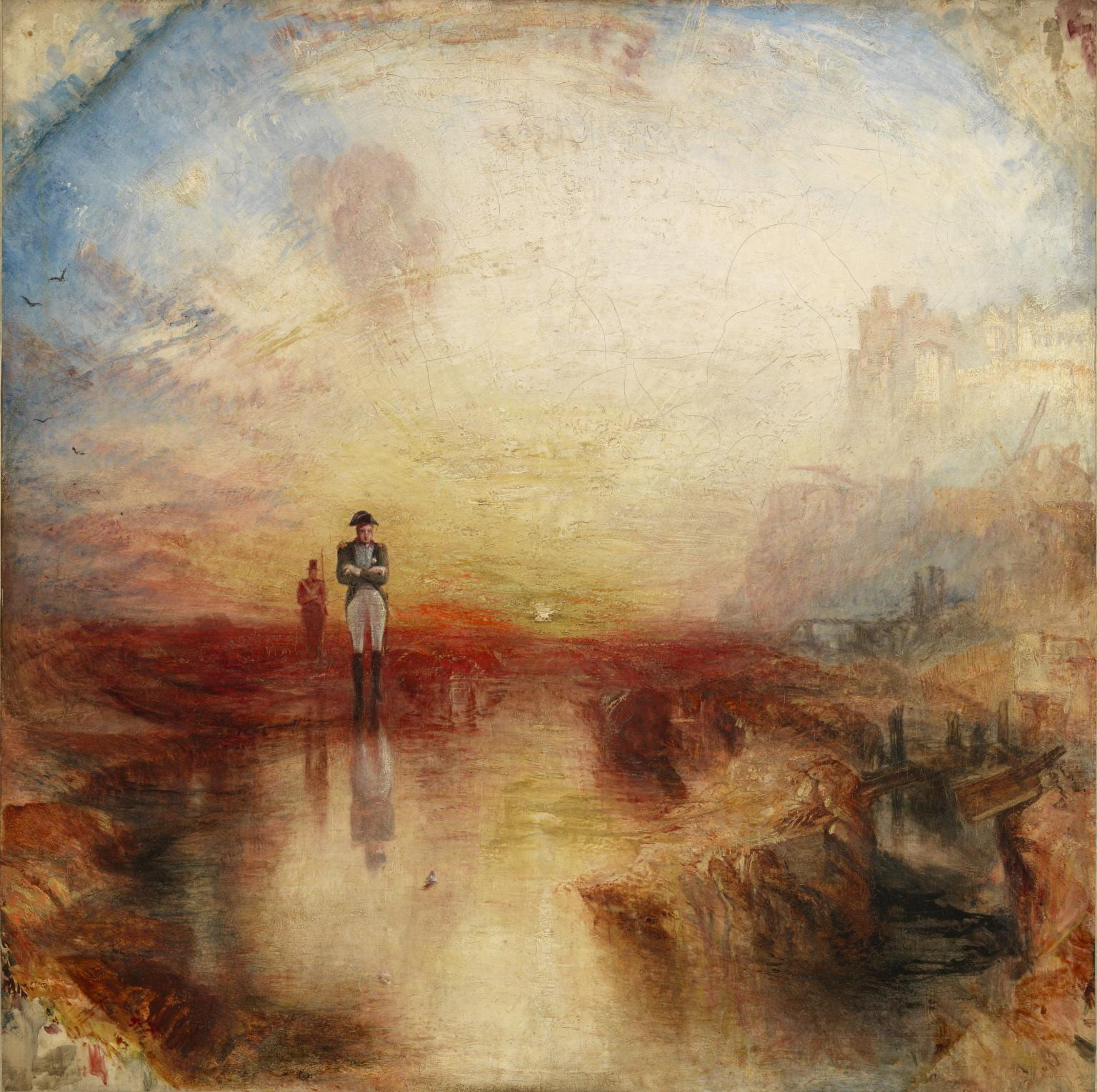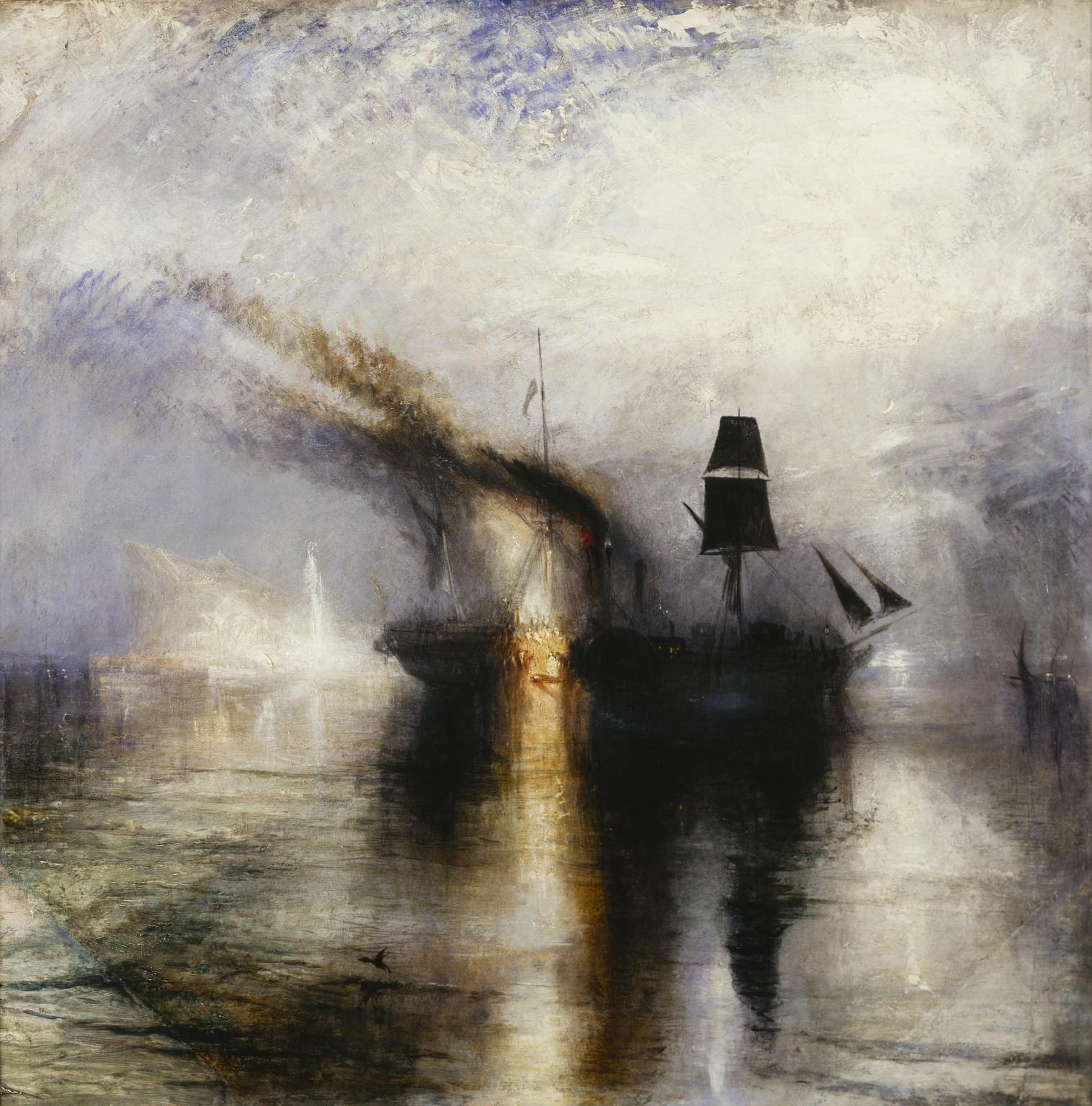By guest contributor Jonathan Potter

J. M. W. Turner, War. The Exile and the Rock Limpet (1842)
Reviewing the 1842 Royal Academy of Arts exhibition, the art critic John Eagles wrote of J. M. W. Turner’s paintings:
They are like the “Dissolving Views,” which, when one subject is melting into another, and there are but half indications of forms, and a strange blending of blues and yellows and reds, offer something infinitely better, more grand, more imaginative than the distinct purpose either view presents. We would therefore recommend the aspirant after Turner’s style and fame, to a few nightly exhibitions of the “Dissolving Views” at the Polytechnic, and he can scarcely fail to obtain the secret of the whole method […] Turner’s pictures […] should be called henceforth “Turner’s Dissolving Views” (“Exhibitions—Royal Academy,” Blackwood’s Edinburgh Magazine, July 1842, p. 26).
The comparison is no doubt intended to reduce the stature of Turner’s paintings from high art to the level of popular performance. Eagles was not a fan of Turner’s work – he begins by suggesting Turner suffered hallucinations—and he reused the dissolving view comparison the following year to note with approval that there were few imitators of Turner’s ““dissolving view” style” (“Exhibitions,” Blackwood’s Edinburgh Magazine, Aug 1843, p. 188). But Eagles was not alone. Much of the press for Turner’s paintings at the 1842 exhibition was negative, concentrating primarily on various aspects which broadly fall into the category of realism: clarity, recognisability, and believability of depiction, amid others.
Part of the problem also lay in Turner’s subject matter—reviewers struggled, for example, to relate the exiled Napoleon and the limpet in War. The Exile and the Rock Limpet with the sea burial of the artist David Wilkie in Peace – Burial at Sea. These two subjects (or three if you include the jarring juxtaposition of emperor and limpet) do not naturally fit within a traditional historiographical narrative or seem to follow a sequential logic.

J. M. W. Turner, Peace – Burial at Sea (1842)
The paintings contradicted reviewers’ expectations by disregarding realist principles of depiction in both form and content. In order to understand them, we need to look beyond the traditions of fine art painting. This, indeed, is what Eagles suggested when he called the paintings “dreamy performances” and directed the reader to consider them as “dissolving views.”
A successor to the phantasmagorias, the dissolving view was a magic lantern show that used a gradual transition (the “dissolve”) from one image to another. This could utilize superimposition or, more often, involve a gradual dimming and elimination of light through one lens whilst proportionally increasing light through another. Dissolving view shows came to prominence sometime in the first part of the nineteenth century (Simon During suggests around 1825 [Modern Enchantments, 102-3]), taking over from the phantasmagoria as the chief magic lantern entertainment.
The dissolving view is unstable and, potentially at least, destabilising, offering an alternative to traditional sequential historiography. The dissolving view presents paired images that blur together as they transition. In dissolving, the images attain, lose, and regain focus and clarity, and, for transitory moments, appear to coincide and coexist with no clear distinction from one to the next. The dissolve blurs the visual field, but it also blurs the semantic fields of content and context.
A handbill for dissolving views at the Adelaide in London, for example, promises a variety of different subjects seen in different states or time frames. The “Water Girls of India” for instance appear in daylight and then in moonlight, followed by the Tower of London in daylight, then moonlight, then on fire. As the lantern changes from one lens to the other, the scene dissolves from day to night and the viewer is given the sense of time passing. Because the subject remains the same, often there is very little movement beyond the changing light or incidental details. The first image (either night or day) implicitly reiterates an aspect (in this case, diurnal/nocturnal light) of the next image which is the past—i.e. the nocturnal image acquires meaning in relation with the diurnal image—and this semantic return of the past implies the next stage in the cycle. The implied sequence follows a causational rationale (day to night to day) but its progression from past to present to future is also a progression from past to present to past. This rhythmic logic is further complicated by the progression to the next subject. There is no clear logical connection between the water girls of India and the Tower of London except that both share a rhythmic temporality (both transform from day to night). The teleology of cause and effect is replaced by coincidence and shared rhythms that are not causation but do allow a certain predictive logic.
This destabilisation is not without form or structure. These kinds of dissolving view present a cycle which intermittently reinstates something resembling linearity and perspectival order, but this linearity is caught in a revolutionary whirl from one to the next and (potentially at least) back again. This is a visual whirl in more than one sense: the blur of the images replicates the visual field of motion and, in fact, dissolving view images were often circular. In essence, the whirling of the dissolving view contains a sense of rhythmic regularity. In images which oscillate between summer and winter or night and day, as magic lantern dissolving views often did, a natural sequential rhythm supplants the linear progressions of dominant conceptions of time and history. Rather than succession and disjunction, the dissolving view infers repetition and conjunction. It acts as a conceptual counterpoint to the linearity of conventional historical thought that emphasizes the sequential logic of cause and effect.
We can see such effects in much of Turner’s paintings at the 1842 exhibition. Turner experimented with circular, octagonal, and square canvases of proportions reminiscent of lantern slides, on which colours characteristically whirl around a central point, and his images suggest forms of motion—most famously in his later painting Rain, Steam and Speed – The Great Western Railway (1844), but also in the angled column of smoke in “Peace”, or the vortexes of colours in the two deluge paintings.

J. M. W. Turner, Rain, Steam and Speed – The Great Western Railway (1844)
If we follow Eagles’s suggestion and consider these as “dissolving views,” then we might consider the two most difficult paintings, Peace and War, as a cyclical binary. The bright sunshine of War melts into the dark clouds of Peace much as magic lantern slides might melt from day to night or summer to winter. The light sources also share a structural unity – that central beam of brightness eviscerating the darkness of Peace is mirrored by the sun’s reflections in War. Thematically, too, there is some unity in the shared representation of the sea, though in War this is a watery shoreline rather than sea proper.
But what about the difficulty of the central subjects? Exiled Napoleon does not so obviously dissolve into David Wilkie’s burial at sea, and any notion of the latter returning back again to the former is more than a little jarring. Perhaps these difficulties are part of the point. They are the difficulties faced by viewers looking for conventional socio-historical links in paintings that, as the metaphorical dissolving view often does, seem to defy such conventions. Turner’s paired paintings demand that the viewer think beyond established norms to reflect upon the meanings of teleological historiographical practice. In pairing Napoleon with the limpet, the human figure of the man is pulled away from the mythology of the emperor.
Turner’s “dissolving views,” notably blurred and indistinct except for their central subjects, seem to be locked in the moment between two images. The space of actual physical objects—the focal point of visible reality and the space of event—is very small in these pictures, confined to only thin bands of land the run across the mid-sections of canvas between water and sky. This is true of all of the 1842 exhibition paintings. The space of visible definition and physical solidity is caught between the indistinctions and contradictions of watery reflection and vaporous sky. The vast majority of painted space is given to indistinction, as though the whirling visual chaos around physical phenomena were as important as the phenomena themselves.
Turner might be, as various critics have suggested, drawing attention to the embodied subjectivity of vision, but he is drawing attention, too, to the ambiguity of interpretation. In the paired paintings, War and Peace, viewers used to history being “for” something (for understanding progress, nationhood, divine provenance, or a multitude of other values) are prevented from resolving the images into a coherent narrative. This is not history as chronology or ideology but as event, to be set within an interpretive framework only by individual observers in full knowledge that such frameworks are not naturally occurring, but imposed, and so necessarily reduce events to certain structures and values. This relates to the metaphorical dissolving view in precisely its insistence that visibility does not equate understanding and that, in the blurry vague expanse around the focussed subject, the flaws and ambiguities in our understanding are rendered visible—great gaps that rupture the certainty of the visible space.
The more certain we, as viewers, are that this is a view of Napoleon on Elba and this is a view of Wilkie’s funeral, the more uncertain we become of our interpretation of the pairing, and the more they converge in contradiction. These two events are juxtaposed, so that their meaning and relational dynamic is left more or less open to the viewer’s interpretation. The structures of historical force (of sequence, of continuum) are rendered visible. In the British solider for instance, Napoleon’s historical past is made visible, as are his imprisoned present and future. However, these forces are not the main agents of meaning in the images—they are peripheral, there to be identified, but attention is not purposely drawn to them. In this sense, these are extra-historical images which probe and question the history they ostensibly project. As dissolving views, these images do not resolve uncertainty, they generate it, they blur conventional structures and obscure dominant historical relations. They inculcate a historiographical perspective of complex relations that evade the organising structures of cause and effect, of sequential succession, of contradistinction and perspectival clarity.
Jonathan Potter recently completed his first book, Discourses of Vision in Nineteenth-Century Britain. He completed his PhD at the University of Leicester in 2015 and currently teaches at Coventry University. Find him on twitter at @DrJonPotter




1 Pingback